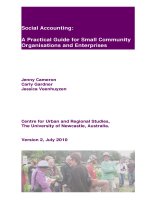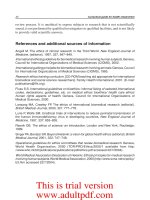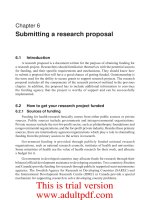SEXUAL ORIENTATION AND SCHOOL POLICY A Practical Guide for Teachers, Administrators, and Community Activists potx
Bạn đang xem bản rút gọn của tài liệu. Xem và tải ngay bản đầy đủ của tài liệu tại đây (3.55 MB, 240 trang )
SEXUAL
ORIENTATION
AND SCHOOL POLICY
Curriculum, Cultures,
and
(Homo)Sexualities
Edited
by
James
T.
Sears
Editorial Advisory Board:
Dennis Altman, Warren Blumenfeld, Deborah
Britzman, Diane DuBose
Brunner, Debbie Epstein, Pat Griffin, Glorianne Leck, Peter
McLaren,
William Pinar, Eric Rofes, and Mariamne Whatley
Getting Ready for Benjamin: Preparing Teachers for Sexual Diversity
in
the
Classroom
Edited by Rita M. Kissen
Troubling Intersections of Race and Sex
Edited by Kevin
K.
Kumashiro
Queering Elementary Education
Edited by William
7.
Letts
IV
and James
T.
Sears
Beyond Diversity Day:
A
Q&A
on
Gay and Lesbian Issues
in
Schools
Arthur Lipkin
Forthcoming
in
the Series
Border Sexualities and Border Families
By Maria Pallotta-Chiarolli
SEXUAL
ORIENTATION
AND
SCHOOL POLICY
A
Practical Guide for Teachers,
Administrators, and Community Activists
Ian
K.
Macgillivray
ROWMAN
&
LITTLEFIELD PUBLISHERS, INC
Lanham
*
Boulder
*
New York
*
Toronto
-
Oxford
ROWMAN
&
LITTLEFIELD PUBLISHERS, INC.
Published in the United States
of America
by Rowman
&
Littlefield Publishers, Inc.
A wholly owned subsidiary of The Rowman
&
Littlefield Publishing Group, Inc.
4501 Forbes Boulevard,
Suite 200, Lanham, MD 20706
www.rowmanlittlefield.com
P.O. Box 3 17, Oxford OX2 9RU, UK
Copyright
0
2004 by Rowman
&
Littlefield Publishers, Inc.
All
rights
reserved.
No part of this publication may be reproduced, stored in a retrieval
system, or transmitted in any form or by any means,
electronic, mechanical,
photocopying, recording, or otherwise, without the prior permission of the publisher.
British
Library Cataloguing in Publication Information Available
Library
of
Congress Cataloging-in-Publication Data
Macgillivray, Ian
K.
1967-
Sexual orientation and school
policy
:
a practical guide for teachers,
administrators, and community activists
/
Ian
K.
Macgillivray.
p. cm.
-
(Curriculum, cultures, and (homo)sexualities)
ISBN 0-7425-2507-4 (cloth
:
alk. paper)
-
ISBN 0-7425-2508-2 (pbk.
:
alk.
paper)
1. Homosexuality and education. 2. Education-Social aspects. 3.
Gays-Identity. 4. Lesbians-Identity.
I.
Title.
11.
Series
LC192.6.M33 2004
37 1.826'64-dc2 1
2003011932
Printed in the United
States
of America
@"
The paper used in this publication meets the minimum requirements of American
National Standard for
Information Sciences-Permanence of Paper for Printed Library
Materials, ANSI/NISO 239.48- 1992.
Dedicated to the High Plains Safe Schools Coalition.
Keep
up
the great
work!
This Page Intentionally Left Blank
Series Editor’s Foreword: James T. Sears, Ph.D.
ix
Foreword: Kevin Jennings xi
Acknowledgments
xv
Part I: Implementing School Nondiscrimination Policy That
Includes Sexual Orientation:
A
Case Study in School
and Community Politics
1 In the Beginning 3
2
A
History of the Two Policies 27
3 Strategies Employed by the High Plains Safe Schools Coalition
to Build Community and District Support 49
4 Lessons from the Case of High
Plains 61
5
Suggestions for Other School Districts and Safe
Schools Coalitions 77
Part 11: Understanding Moral Conservative Opposition
to
School Policies
That Include Sexual Orientation
6 Opposition to Educational
Change 83
7
How the Various Sides in This Debate Make Meaning of
the Policies 91
8
Why
the Various Sides Support
or
Oppose the Inclusion of Sexual
Orientation in the Policies 111
-
v11-
Vlll
Con
tents
9
Conclusion: How to Evaluate the Competing Claims
of
Violations
of
Rights
143
Epilogue: My Reflections on This Research
167
Appendix
A On the Making of
Sexual Orientation and
School
Policy
175
Appendix
B:
Methods of Data Analysis
187
Appendix
C:
Validity and Reliability
193
Appendix D: HPSD’s Nondiscrimination Policy
197
Appendix E: Diversity Goal Statement with Beliefs from
Strategic Plan
199
Appendix
F:
Associated Regulations That Support the
Nondiscrimination Policy
20
1
Bibliography
21 1
Index
217
About the Author
223
Series Editor’s Foreword
James
T.
Sears,
Ph.D.
UR
NATION’S
SECONDARY
SCHOOLS
HAVE
experienced remarkable progress
0
in addressing lesbian, gay, bisexual, and transgender (LGBT) concerns.
From the formation of gay-straight alliances to the
adoption of antiharass-
ment policies, being a queer high
school student is in some ways quite differ-
ent from my experience a generation ago.
Progress, however, can only be judged from my
Ozzie and Harriet
vantage
point-an era when every state
criminalized homosexuality, when the psy-
chiatric profession diagnosed it as an illness, when no religious denomina-
tion sanctified homosexual
relationships, and when teachers were entrapped
and summarily dismissed because
of
their sexual orientation. Even today,
relatively few schools have recognized gay student groups (the drama club
notwithstanding); little protection is provided to LGBT educators or pupils;
the curricula that include the contributions of acknowledged
lesbians and
gay men are rare as are pedagogical practices that are inclusive; and queer-
ing elementary education is more likely found on a bookshelf than in the
classroom.
Within
this historical context a new generation
of
scholars and researchers
are peering into the black box of schooling. They are
asking difficult ques-
tions, often challenging our simple-minded equation that policy reform
equals school change. One of these inquirers is Ian
K.
Macgillivray, an openly
gay classroom teacher with
an earned doctorate who came out to the music of
Boy George and George Michael.
Macgillivray takes us to America’s heartland through an exemplary ethno-
graphic
inquiry. In
Sexual Orientation and
School
Policy,
we enter High Plains
-
1x
-
X
Series Editor’s Foreword
School District, which has already included sexual orientation in its nondis-
crimination statement but over the ensuing years has done little more-to the
point that its existence has been all but forgotten. When a new initiative is
proposed, not surprisingly, the participants experience
conflict. Here, voices
and images
of
local gay activists and moral conservatives are lucid and lively
as they (and we) are drawn
behind the battle lines in the Rocky Mountain
high country. The result is as compelling as it is disturbing.
In this case study, what is most provocative is not the finding that there are
slippages or loose couplings between
policy adoption and implementation.
Those of us engaged in policy
analysis or everyday school practice are well
aware
of
this divide. What is thought provoking is how democratically com-
mitted, social justice-oriented persons apply
the principle of equality in their
pursuit of the “gay agenda.” Macgillivray’s position is clear:
“I
am asking the
schools to teach democratic principles like equality and reciprocity;
I
am not
suggesting that the school teach or require students to ‘value’ homosexuality.”
And, it is at this juncture-where the high terrain of political
philosophy and
the bog
of
educational practice meet-that sexual orientation can be squared
with school policy. If we
can
marshal our resources here, then the next gener-
ation
of
queer youth-from the High Plains of the Rockies to the Low Coun-
try of the Carolinas-need not suffer through either Ricky Nelson or Boy
George. (Re)visioning
Sexual Orientation and School Policy
is worth the effort.
Foreword
Kevin
Jennings
s
BOTH
A
HISTORY TEACHER
and a social justice activist,
I
sometimes think that
A
the popularized history of the life of Martin Luther King Jr. has given rise
to profound misconceptions about how justice and equality
are won. In the
“made for television” version of King’s life that we celebrate each January, one
could think that justice is won by giving one moving
speech invoking a “dream”;
after which, lawmakers enact
the right legislation, and the citizenry falls in line.
I
am sure that, were King alive today, he’d watch this and say,
“I
wish.’’
Hollywood prefers a version of history focused on charismatic individuals
who resolve all the hard issues in less than
two
hours. Real change is not
so
easy. While individual leadership and the enactment of legislation play im-
portant roles, social justice is won by citizens who
commit themselves to the
painstaking, slow, and trying work that winning it involves. The passage of a
law
is the beginning of the
end, not the end of the beginning, of the process
by which equity is made a reality in everyday
life for those who have been de-
nied it. The hard work of winning
such laws, and then ensuring they are im-
plemented in ways that make a difference in our lives, is a
complex story rarely
told on the silver screen.
There is no denying that equity in our schools is not forthcoming for les-
bian, gay, bisexual, and transgender (LGBT) students. The
2001
Gay, Lesbian,
Straight Education Network (GLSEN) National School Climate Survey found
that over
80
percent of these students experience verbal, physical, or sexual ha-
rassment while at school. The
2001 Massachusetts Department of Educa-
tion/Center for Disease Control and Prevention (CDC) Youth Risk Behavior
Survey found that LGBT students were over three
times as likely to skip school
-xl-
xii
Foreword
and over four times as likely to attempt suicide as their non-LGBT peers. The
ideal upon which our public education system was
founded-a free education
that would enable every child to achieve their human potential and become
a
full citizen in society-is far from
a reality for most LGBT students.
Over the past decade, awareness
of this inequity has been growing, and ef-
forts to address it have been increasing. Eight states
(California, Connecticut,
Massachusetts, Minnesota, New Jersey, Vermont, Washington, and Wisconsin)
now
protect students from harassment and/or discrimination based on sexual
orientation. Three states (California, Minnesota, and New Jersey) now protect
students from harassment and/or discrimination based on gender
identity.
Student leadership has played an important role in
changing our schools: high
school-based and student-led gay-straight alliances have spread from
a lone
one in Concord, Massachusetts, in
1989,
to over two thousand in all fifty states
as of
2003.
As
LGBT students and their supporters have become visible and
have begun to insist on more equitable treatment in our schools, authorities
at
the local, state, and even federal level have begun to take note and, in
many
cases, take action.
But those seeking equity for LGBT people in our schools confront a basic
problem: because this work is
of such recent vintage, no road map exists to
show how to best achieve this goal. In
Sexual Orientation and School Policy:
A
Practical Guide for Teachers, Administrators, and Community Activists,
Ian
K.
Macgillivray gives us a much-needed and long-overdue case study of how this
process actually unfolded
in one community. The story of the struggle to
make the High Plains
School District a more equitable place for LGBT stu-
dents is an instructive, fascinating
one. We learn how citizens organized the
High Plains Safe Schools Coalition to push for change-the tactics
they em-
ployed, the obstacles they encountered,
and the victories and setbacks they ex-
perienced along the way. What emerges are
lessons for those activists organiz-
ing for change and for those
education
leaders seeking guidance on how to
change their schools to be more inclusive.
Macgillivray makes a singularly unique contribution to our understating of
the process of change by his analysis
of the “slogan systems” of those sup-
porting and those opposing
the changes advocated by the High Plains Safe
Schools Coalition. Macgillivray helps
us understand where each side is com-
ing from and why conflict results. While
Macgillivray shows that the two sides
can demonstrate profound
(and in some ways irreconcilable) differences in
their worldviews, his analysis can nonetheless
help more communities move
productively through the process of change, whereby they
minimize the
“shouting matches” that too often occur.
Eleanor Roosevelt once said,
“Where do universal human rights begin? In
small places, close to home.” In
Sexual Orientation and School Policy:
A
Prac-
Foreword
XI11
tical Guide for Teachers, Administrators, and Community Activists,
Ian
K.
Macgillivray shows us how the process of winning one of the basics rights in-
cluded in the Universal Declaration of Human Rights that Mrs. Roosevelt in-
spired-the right to an education-unfolded “close to home,” in the real
world of a typical American community. It is
my hope that this insightful, in-
cisive study of the process of winning social justice
for LGBT students in the
High Plains School District will help more
school systems become places
where this universal human right is afforded to all young people, regardless of
sexual orientation or gender identity.
Kevin Jennings, Executive Director
Gay, Lesbian, Straight
Education
Network (GLSEN)
This Page Intentionally Left Blank
Acknowledgments
RITING
THIS
BOOK
HAS
TRANSFORMED
ME,
and I wish to thank many peo-
w
ple for their love and support in this endeavor. First and foremost
I
would like to thank my parents and best friends, Tom and Barbara
Macgillivray, who have supported me in numerous ways and who always en-
couraged me to stand up for my convictions.
I
could not have done this with-
out their love and support.
I would like to thank the rest of my family, who
helped raise me and helped make me the person
I
am today. Many thanks to
my grandparents, Ian Callum and
Marjorie Aitkens Macgillivray and Kenneth
Henry and Dorothy Grefe Ruf. Thanks also to my sister and brother-in-law,
Magi and Aaron Ramirez, my nephew, Riley, and my niece, Phoebe, for their
love and support.
I would also like to
thank
all
of the participants of this research who took
time out of their busy
schedules to be interviewed, to talk on the phone, to an-
swer e-mails, and to make this book complete. Special thanks goes to Dorothy,
president of the High Plains Safe Schools Coalition, who is tireless in
her ad-
vocacy for the rights of gay, lesbian,
bisexual, transgendered, intersexed, and
queedquestioning (GLBTIQ) students and adults. Many thanks also to
other
members of the High Plains Safe Schools Coalition,
including Roger and
Marge, who pointed out numerous
grammatical errors in my manuscript!
Tons of love and respect
go
out to Violet, director of the High Plains GLBTIQ
Youth Support Group for her passion and drive to help
queer youth develop
into adults with healthy GLBTIQ identities. Finally,
I
offer a very special thank
you to Nancy of Concerned Citizens for her
forthrightness and tenacity.
-xv-
xvi
Acknowledgments
I
wrote the bulk of this book as a doctoral student and have my dissertation
committee to thank for helping
me to turn out a product of which
I
am very
proud. Many thanks to Emily Calhoun, Maria
Franquiz, Ken Howe, Karen
Harbeck, and especially to my co-advisors, Margaret
LeCompte and Steve
Guberman. You have my love, admiration, and respect, not only as
academics,
but also as just-minded individuals.
I
would also like to thank Dean William
Stanley and the professors and staff
of
the School of Education at the Univer-
sity of Colorado at Boulder, where
I
completed my Ph.D., made many won-
derful friends, and made my entree into the world
of
academia. Thanks also
to the late John Rawls, philosopher
and author. You inspired me.
Words cannot express what
I
feel for Steven D. Hopp, Delores
B.
Kellman,
David Lynden Francis, Robert Davis, Manuel Alvarado R., Erick Brunner, Tom
Dempsey, and Daryl
J.
Walker, who continue to teach me about life, love, and
the human spirit. Thanks also to my high school
theater friends, especially
Karen Atkinson, who
helped me be strong. And tons of hugs and kisses to
Gerardo. You are
so
special.
Last, but certainly not least,
I
thank all of my teachers.
I
especially thank Bill
Nielsen, my high school biology
teacher, for making his classroom safe. One
teacher can make the difference between life and death.
implementing
School
Nondiscrimination
Policy That
includes Sexual Orientation:
A
Case Study in School and
Community Politics
Never
doubt
that
a
small group
of
thoughtful, committed people
can
change the world. Indeed it
is
the
only
thing
that ever
has.
-Margaret
Meade
This book is a true story about a small group of thoughtful,
committed peo-
ple who changed their own corner of the world.
I
wrote this book to share
with others
the strategies that this group employed
in making their world a
better and more just place to live. It is my hope that
the accomplishments of
this group will inspire you, as they have me.
Part
I
introduces this group, details their advocacy on behalf of gay, lesbian,
bisexual, transgendered, and queedquestioning students, and makes sugges-
tions for other community groups and school
districts in cultivating school
cultures of safety and respect.
I
open part
I
with a little bit about myself to
help the reader understand my personal commitment to and involvement in
this issue.
This Page Intentionally Left Blank
1
In the Beginning
LLOW
ME
TO
STATE
MY
BIASES
UP
FRONT.
I
am a gay man.
I
am the survivor
A
of a middle and high school experience filled with antigay abuse. Day in
and day out,
I
was punched, kicked, spit upon, shoved into lockers, and called
terrible names. Although
I
learned to walk very quickly from class to class in
an attempt to avoid abuse
in the hallways,
I
was not completely safe in the
classrooms either. Teachers rarely stopped name-calling and often missed the
punches and objects hurled at me
when their backs were turned. Several times
I
came close to taking my own life to end the pain inflicted on me by other
students, teachers, and even administrators. The message
I
received every day
for
six
straight years was, “You are not worthy. You do not deserve to be here.
You are despicable. Die, you faggot.”
Looking
back at my childhood,
I
was a boy who identified more with girls
and women.
I
identified with the nurturing roles women and girls often took
in relationships with others.
I
did not identify with boys my age who were
constantly punching one another and frequently torturing neighborhood cats
and
other defenseless animals. However, when
I
first started to develop sexual
feelings, they were directed toward
men.
I
don’t know if
I
was born gay, but
I
do know that my sexual orientation was set in place from the time of my ear-
liest recollections.
I
was born to and raised by heterosexuals.
I
grew up in a
culture that valued heterosexuality above all other sexual and affectional ex-
pressions.
As
a boy
I
was prodded to take on heterosexual and masculine roles
by family members who bought me
BB
guns and toy trucks and inquired as
to how many girlfriends
I
had. My peers admonished me when
I
“acted like a
girl.”
I
should have turned out straight, but
I
didn’t.
-3-
4
Chapter
1
I
quickly realized that
I
was different from other people, and
I
learned to
monitor my thoughts and actions
so
I
would fit in with the heterosexual ma-
jority.
I
didn’t know what it meant to be gay until
I
was in middle school.
When
I
learned what it meant,
I
began to wonder if that was what
I
was.
I
didn’t want to believe
I
was gay because
I
knew the negative context in which
being gay was discussed by other people. By the time
I
entered my freshman
year of high school, however,
I
had accepted the fact that
I
was gay.
I
told no
one.
I
felt that
I
was the only gay person in the world and that no one could
possibly understand how
I
felt-that is, until Culture Club hit the popular
music charts and
I
caught my first glimpse of Boy George on an album cover.
I
remember it vividly.
I
was shopping with my family when the words
Culture
Club
caught my eye.
I
was just becoming interested in music and knew the
band’s name from
listening to the radio. What really caught my attention,
though, was the figure on the cover. Was it a man? Was it
a woman?
I
couldn’t
tell.
I
examined the back
of
the album cover and discovered that the androg-
ynous figure who caught my eye was named Boy George. “He
must be a man,”
I
thought. “But why is he dressed like a girl?”
I
had to know more about this
person. My parents bought me the album, and Boy George
became not only
my pop idol but, oddly enough, my savior.
At last,
I
knew that someone else out there was like me.
I
bought every one
of Culture Club’s albums.
I
bought every teen magazine, poster, and any other
artifact that was emblazoned with Boy George’s image or had
anything to do
with this magnificent being who
broke all the rules of gender. The walls of my
bedroom were plastered from floor to ceiling with images of Boy George.
When
I
wasn’t in school,
I
was locked in my bedroom listening to Culture
Club’s albums, staring at Boy George all
over my walls, and dreaming of run-
ning away to London (where
he lived), and being his friend. This was how
I
spent
two
years of my early high school life. This was how
I
dealt with the phys-
ical pain and emotional misery inflicted upon
me by my classmates, teachers,
administrators, and the larger society that devalued people like
me. Deep in-
side
I
knew that Boy George was like me. Knowing that at least one other per-
son out there in the world felt
like
I
did made life almost bearable. The fact that
I
had
no
access to Boy George-the one person who
I
thought would accept
me for who
I
was-made it all the more difficult to cope with my pain and iso-
lation.
I
often contemplated suicide as a way
of
ending my misery and loneli-
ness.
I
also dreamed of killing the students at school who physically and ver-
bally tortured me, who
humiliated me in front of others and denied me human
dignity.
I
knew they had no right to treat me the way they did, and
I
was furi-
ous at the injustices they perpetrated against me; yet
I
was powerless. Years
later, when
two
young gunmen massacred their teachers and classmates at
Columbine High School in Colorado,
I
understood how years of teasing and
5
In
the
Beginning
bullying by other students may have helped push the two young gunmen to
their act of rage (Pankratz
2002).
Though I do not condone their actions-in-
deed,
I
am as horrified as everyone else-I was not surprised to hear that the
two young men were often
the victims of antigay bullying by the more popu-
lar students and by the students
who were active in sports (Greene
1999).
I
have since made peace with my public school experience. I survived the situa-
tion and came out of it with
a greater understanding of human suffering, the
ability to empathize with
others, and a great deal of compassion. Now the
memories of those days drive me to make this world a better place for
other
young gay, lesbian, bisexual, transgendered, intersexed, and queedquestioning
(GLBTIQ) people who find themselves in similar positions.
I
do not blame my teachers and administrators who did little or nothing to
stop the abuse and who,
in fact, often perpetuated it. I do not blame the stu-
dents who tormented me. We were all trying to make
sense of a situation that
was new to us. By the time
I
was a junior in high school, I had found some sol-
ace in the drama club.
Many students in theater were also social outcasts, and
they accepted me into their
group. There were tensions between students who
were in sports and those in theater and choir. At one
point “the Klan,” a self-
named group of boys in sports,
organized in opposition to “the theater fags,”
the term they used for students in theater and choir. The Klan appointed
lead-
ership and a “Klan artist” and began littering the hallways with hand-drawn
flyers containing derisive messages aimed at students in
theater. At this point
the school’s administration finally stepped in, determined who “the Klan”
members were, put an
end to their
organization, and offered counseling to
those of us in theater
who were being harassed (notice that the victims were
the ones treated as though they
had
a problem to get over). We were told to
come to the office
every time another student harassed us and report that stu-
dent.
I
reported offenders for a while, and, if my recollection serves me cor-
rectly, a few students were temporarily suspended as a result. However,
I
real-
ized that I was fighting
a battle much larger than myself and that nothing
really changed despite my reporting,
so
I
finally gave up.
When
I
became a senior,
I
was given the opportunity to attend a university
in a nearby town in
the mornings and finish my high school courses in the af-
ternoons. The first course
I
signed up for at the university was a multicultural-
ism course called
Nonoppressive Relationships.
This course taught me about
sexism, racism, classism, homophobia, and other oppressions; and finally, my
world started to make sense.
I
took on a view of society much larger than the
one afforded by my microcosmic high school experience.
I
began to under-
stand the discrimination directed at me by my peers. By no means did
this
greater understanding paint
a rosy picture of my future life as a gay person. It
did, however, offer an
understanding of why oppression and discrimination
6
Chapter
1
exist. This discovery was a huge relief, and it at least gave me hope that I could
change life for the better. I was mentored by a professor who was bisexual and
in
a lesbian relationship. She told me about the university’s Gay and Lesbian
Support Group, and
I
knew I had to attend. Although it was difficult for me as
a high school student to walk into
a room full of college students,
I
was imme-
diately accepted by the group, and my intimidations subsided. The group was
facilitated
by a Catholic priest-who later
came out of the closet and was
forced to leave the church-and it included GLBTIQ college students as
well as
community members.
I
was young and nalve, and the potential existed for me
to be manipulated by and preyed upon by older gay men in
the group. Several
older men in the group tried to get my interest, but by and large other group
members
took me under their wings and helped me grow into a confident and
savvy young gay person who
could navigate gay male culture and avoid being
manipulated by others. At last,
I
was no longer alone in the world.
Thus, my initiation into gay culture
occurred while I was still a senior in
high school.
I
was not yet out to my parents,
so
to hide my sexual orientation,
I
pretended that
I
was going to my part-time job when
I
was actually going to
the Gay and Lesbian Support Group meetings.
I
would walk out of the house
in my blue polyester McDonald’s uniform
with a change of clothes in my bag,
and
I
would change in the parking lot when
I
got to the support group meet-
ings. Because my newfound friends were of college
age,
I
was also initiated
into the world of parties, club
going, and drinking. On weekends
I
would join
my friends on treks to Minneapolis, where they would
help me sneak into gay
bars. At last
I
was surrounded by people like myself, and I reveled in the expe-
rience of feeling free for
the very first time.
As
a young person still in high
school, I was certainly vulnerable to being corrupted by these experiences, but
I was raised by parents who instilled strong values in me. I did not succumb
to the temptations of drugs and alcohol, and I did
not “take to the streets” as
some young GLBTIQ people in my position
often do. I finished my studies,
graduated from high school, and went on to postsecondary education.
Nor
did the older GLBTIQ people with
whom
I
was associating ever take advan-
tage of me sexually. Aside from
a couple of older gay men who told me they
wanted to have sex with me (but did
not pursue it when
I
told them no), none
of the other group members ever tried to manipulate me for sex. On the
con-
trary, they were protective and supportive
of
me, and they educated me about
safe sex practices just
as
HIV/AIDS was making its entrance into our social
world. I was very fortunate.
With the support
of
my new gay friends,
I
was encouraged to come out to
my parents, even though some of my friends had
been disowned by their fam-
ilies when they came out. Coming out to my parents was something
I
wanted
to do because
I
felt that
I
was lying to them about who
I
was. I was also lying
7
In
the
Beginning
to my parents about where
I
was going, what
I
was doing, and with whom
I
was associating.
I
was tired of the lies, yet
I
was terrified of being rejected by
my parents. Coming out
to my parents was the most difficult thing
I
have ever
done. When, as a high
school senior,
I
finally worked up the courage to come
out,
I
armed myself with a book, at the suggestion of my professor mentor, en-
titled
Now That
You
Know: What
Every
Parent Should Know about
Homosexu-
ality.
I
decided to come out to my mom first, as
I
thought she’d take the news
better than my dad. On the Saturday morning
I
decided to come out to my
mom, she was lying in bed
reading a book.
I
stood outside my parents’ bed-
room door, clutching the copy of
Now That You Know
tightly in my hands, and
trying to work up the
courage to enter the room. Just
as
I
had lost the nerve
and was turning around to leave, my mom saw my reflection in the glass of a
picture
hanging in the hallway. She asked, “What are you doing?”
I
took a deep
breath, walked in and kneeled down on the floor next to her.
I
don’t remem-
ber my exact words, but
I
prefaced what
I
had to say with something like,
“Mom,
I
want you to know that
I
love you and don’t want to hurt you and that
I’m the same person I’ve always been but
.
.
I’
And then
I
said it-‘‘I want you
to know that I’m gay.” She took it pretty well. She tried
to act as though she
wasn’t upset, although
she visibly was, and she said that I shouldn’t tell my
dad.
I
gave her the book and left the house to get away. When
I
returned that
evening, she had told my dad. My dad took it
better than
I
had expected. He
told me he loved me and
that
I
would always be his son. That was just what
I
needed to hear. Finally, the burden
I
had been carrying all of those years was
lifted from my shoulders.
I
didn’t know what lay ahead, and
I
knew there
would be a period of getting
reacquainted with my parents, now as their “gay
son”; but
I
was relieved. The love and support of my friends from the Gay and
Lesbian Support Group, along
with the love and support of my parents,
started me on the way to becoming a well-adjusted and happy
young gay man.
Though my parents requested that
I
not come out to others, including rela-
tives,
I
started to come out to more and more people at school.
I
became the first openly gay student in my school district in my small town
in central Minnesota in the early
1980s.
I
had the opportunity to
go
back recently
and talk to the teachers and administrators
about my school experience. Many of
them were new
to
the district, but the older ones remembered me. They ex-
pressed remorse for not knowing
what to do back then to stop the abuse.
Students are still the victims of antigay abuse
in my old school and schools
across the country. Teachers and
administrators are still unsure
of
how to ad-
dress the situation. Few schools have made real commitments to end antigay
abuse,
although some schools are trying and that gives me great
hope. Anti-
gay bias must be
eradicated from America’s schools. GLBTIQ students, as well
as students who are perceived to deviate from heterosexual norms, deserve
8 Chapter
1
equality of educational opportunity. Bullying-both physical and verbal ha-
rassment-needs to end, and the
curriculum and practices of the school must
include GLBTIQ people and perspectives to the extent that heterosexual peo-
ple and perspectives are already included.
I
believe the principles of democracy, upon which this country was
founded, and the
U.S.
Constitution demand that all students, including GLB-
TIQ students, deserve equality of educational opportunity in America’s pub-
lic schools. These are my biases. One goal of this book is to illustrate by ex-
ample one school district’s attempt to stop antigay abuse in
its schools. My
hope is that other school districts will
use this information to stop antigay
abuse in their
own
schools and use the philosophical foundations
I
present
here to help bring
about equality for GLBTIQ students.
How
This
Book
Came
About
“I
wish someone would publish a guide for this sort of thing. We need strate-
gies that work.” This sentiment has been repeatedly told to me
by school ad-
ministrators, teachers, and community activists who
are working to increase
safety and equity for
their GLBTIQ students. All over the country, school pro-
grams and groups of local activists are creatively employing
strategies and tak-
ing advantage of various opportunities to make their local schools safe and
welcoming places for GLBTIQ students. In speaking
with
these individuals,
however,
I
learned that they are
so
busy with their advocacy that they do not
have the time to record their
accomplishments and how they achieved them.
The idea for this book grew out of these conversations
with directors
of
programs such as:
“Project
10”
in the
Los
Angeles Unified School District,
“Support Services for Sexual Minority Youth in the San Francisco Uni-
fied School District,
“Out for Equity” in the St. Paul
School District, and
“Out
4
Good” in the Minneapolis School District.
All of these programs provide support services to GLBTIQ students;
profes-
sional development to teachers and administrators; advice on legal require-
ments; and assistance in forming policies and in
developing inclusive curric-
ula.
All
of these programs have faced opposition in one form or another,
whether from resistant school boards and administrators or from
religious
fundamentalist parents in the community who felt the schools were advanc-
ing
a “pro-gay’’ agenda.









